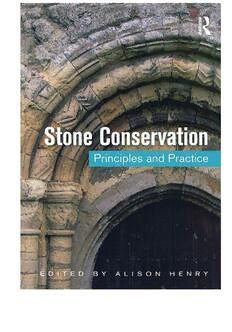
Stone Conservation: Principles and Practice PDF
Preview Stone Conservation: Principles and Practice
Stone Conservation Principles and Practice Page Intentionally Left Blank Stone Conservation Principles and Practice Edited by ALISON HENRY Managing Editor JILL PEARCE Routledge Taylor & Francis Group LONDON AND NEW YORK First published 2006 by Donhead Publishing Ltd Published 2015 by Routledge 2 Park Square, Milton Park, Abingdon, Oxon, 0X14 4RN 711 Third Avenue, New York, NY 10017, USA Routledge is an imprint of the Taylor & Francis Group, an informa business © Taylor & Francis 2006 Ah rights reserved. No part of this book may be reprinted or reproduced or utilised in any form or by any electronic, mechanical, or other means, now known or hereafter invented, including photocopying and recording, or in any information storage or retrieval system, without permission in writing from the publishers. Product or corporate names may be trademarks or registered trademarks, and are used only for identification and explanation without intent to infringe. ISBN-13: 978-1-873394-78-6 (hbk) Typeset by Aarontype British Library Cataloguing in Publication Data Stone conservation: principles and practice 1. Stone buildings - Conservation and restoration 2. Building stones - Biodeterioration I. Henry, Alison 691.2 ISBN-10: 1873394780 Library of Congress Cataloguing in Publication Data A catalog record for this book has been requested Contents Acknowledgements ix Foreword xi John Ashurst 1 Introduction 1 Alison Henry 2 The Historical Context 9 Peter Burman and Michael Drury Introduction 9 The influence of antiquity 10 The break in tradition 13 Re-evaluating tradition 13 The influence of the Modern Movement 23 The continuity of craft practice today 24 International conservation charters and standards 28 Complementary disciplines 28 Guidelines for present and future policy 29 3 Restoration versus Conservation 33 Michael Drury Restoration 33 Preservation 36 Conservation 38 Case study: Salisbury Cathedral, West Front 49 4 The Role of Archaeology 57 Jerry Sampson The role of archaeology in stone conservation 58 Preliminary survey 61 Closer inspection 63 Monitoring work in progress 69 vi STONE CONSERVATION 5 Principles and Practice 75 Nicholas Durnan and Colin Muir Inspection, analysis and methodology 75 Repair and conservation 79 Stone replacement 85 Conservation records 87 6 Sourcing and Selection of Stone for Repair 89 Ewan Hyslop Introduction 89 The decision to replace stone 89 The choice of stone 91 Testing of stone 93 Sourcing of stone from quarries 96 Conclusion 98 7 Consolidation 101 Clifford Price Introduction 101 Historical perspective 103 Properties and performance requirements 104 Consolidant types 105 Application of consolidants 116 Evaluating the effectiveness of consolidants 118 When are consolidants used? 120 The future 122 8 Cleaning Techniques 127 Kyle C. Normandin and Deborah Slaton Introduction 127 Causes and identification of soiling 128 Stone properties and choice of cleaning method 132 Selection of cleaning techniques for stone 136 Quality control and the evaluation of facade cleaning 155 Conclusion 156 9 Limestone 161 Nicholas Durnan Introduction 161 Characteristics of limestone 162 Main types of limestone decay 163 Techniques for limestone conservation 166 Inspection, maintenance and re-treatment 184 CONTENTS vii Sandstone 191 Colin Muir Introduction 191 Sandstone characteristics 192 Sandstone decay and treatment 192 Cleaning 205 Consolidation 210 Pointing and bedding mortars 211 Plastic repair 212 Marble 217 Jonathan Kemp Introduction 217 Marble decay mechanisms 222 Conservation of marble 226 Polychrome Stone 237 Christopher Weeks Introduction 237 Monumental polychromy in medieval and Renaissance culture 237 Polychromy techniques and style 238 Distribution of polychromed facades in Europe 243 The contemporary state of preservation of painted stone 244 Practical issues of conservation 247 Treatment 248 Conclusions: future trends 255 Church Monuments 263 David Carrington Introduction 263 Materials commonly used 263 The historic building environment 270 A brief history of monument restoration and conservation 270 Investigation and analysis 273 The need for structural interventions 276 Dealing with damp 2 77 Considerations in cleaning monuments 278 Dismantling, rebuilding and structural repairs 278 Surface repair and consolidation 286 Case studies 287 viii STONE CONSERVATION 14 Graveyard Memorials 299 Chris Daniels Introduction 299 Deterioration of graveyard structures 300 Inspecting, reporting and recording 306 Working on site 308 Remedial work 310 Emergency work to graveyard structures 322 Maintenance 324 Conclusion 325 Appendix 327 Practical application procedures for putty lime mortar repairs and sheltercoat Index 329 Acknowledgments The Publisher and the Editor would like to offer their gratitude to Peter Burman for the original ideas which inspired this book. It emerged from Peter’s insight that the annual Stone Conservation course at the University of York offered a snapshot of the art and science of conserving stone structures. Peter’s enthusiasm for the project had as its inspiration the remarkable late twentieth-century flowering of the conservation of traditional materials in cathedrals and country houses. Peter was also at that time the founder chairman of both the Building Limes Forum in the UK, and the York Art Workers’ Association, and a past master at bring- ing together architects, art historians, craftsmen, conservators, artists and other professionals in a relationship which enabled the whole to be greater than the sum of the parts; hence, this interdisciplinary book on stone conservation.
